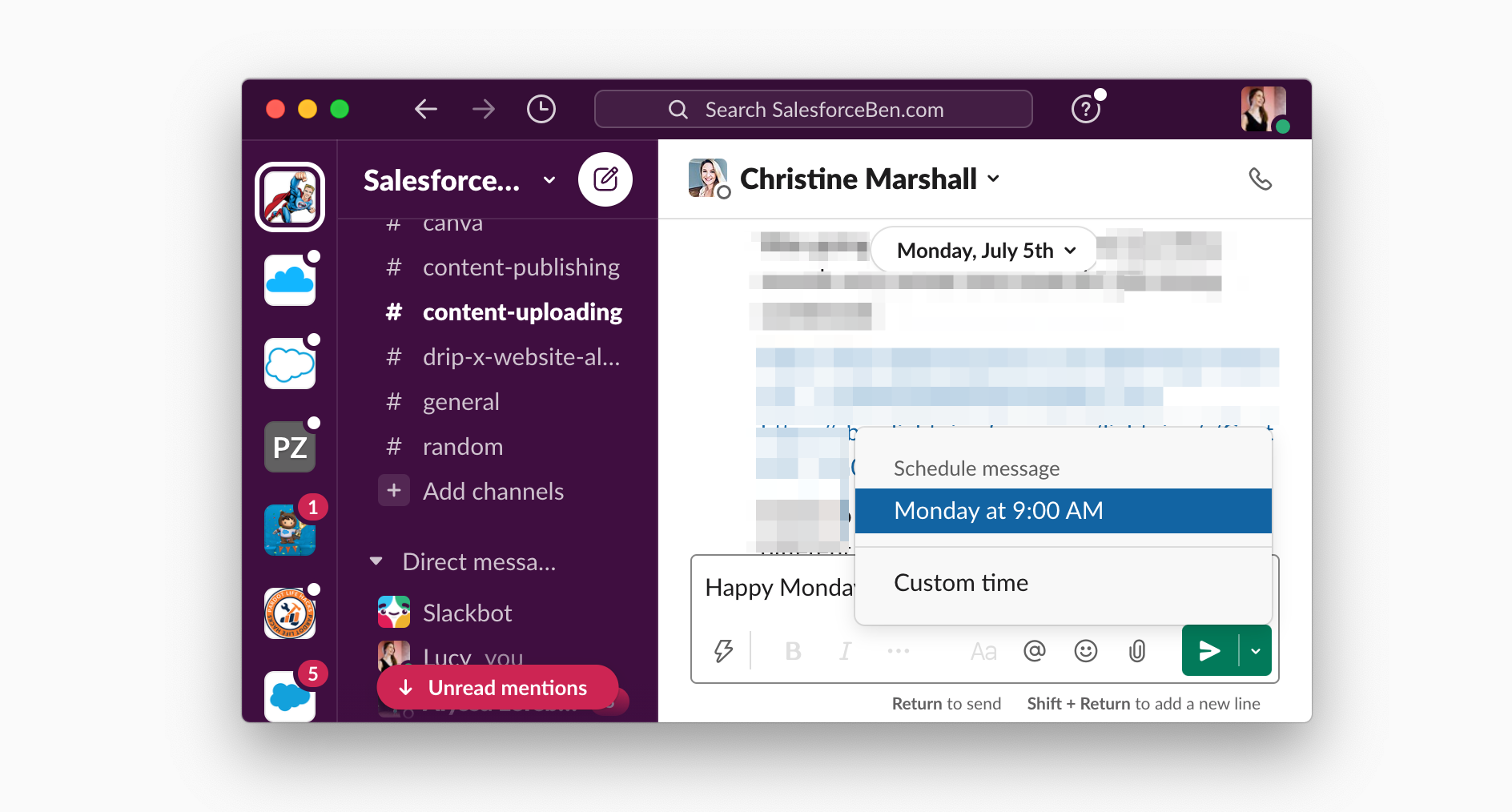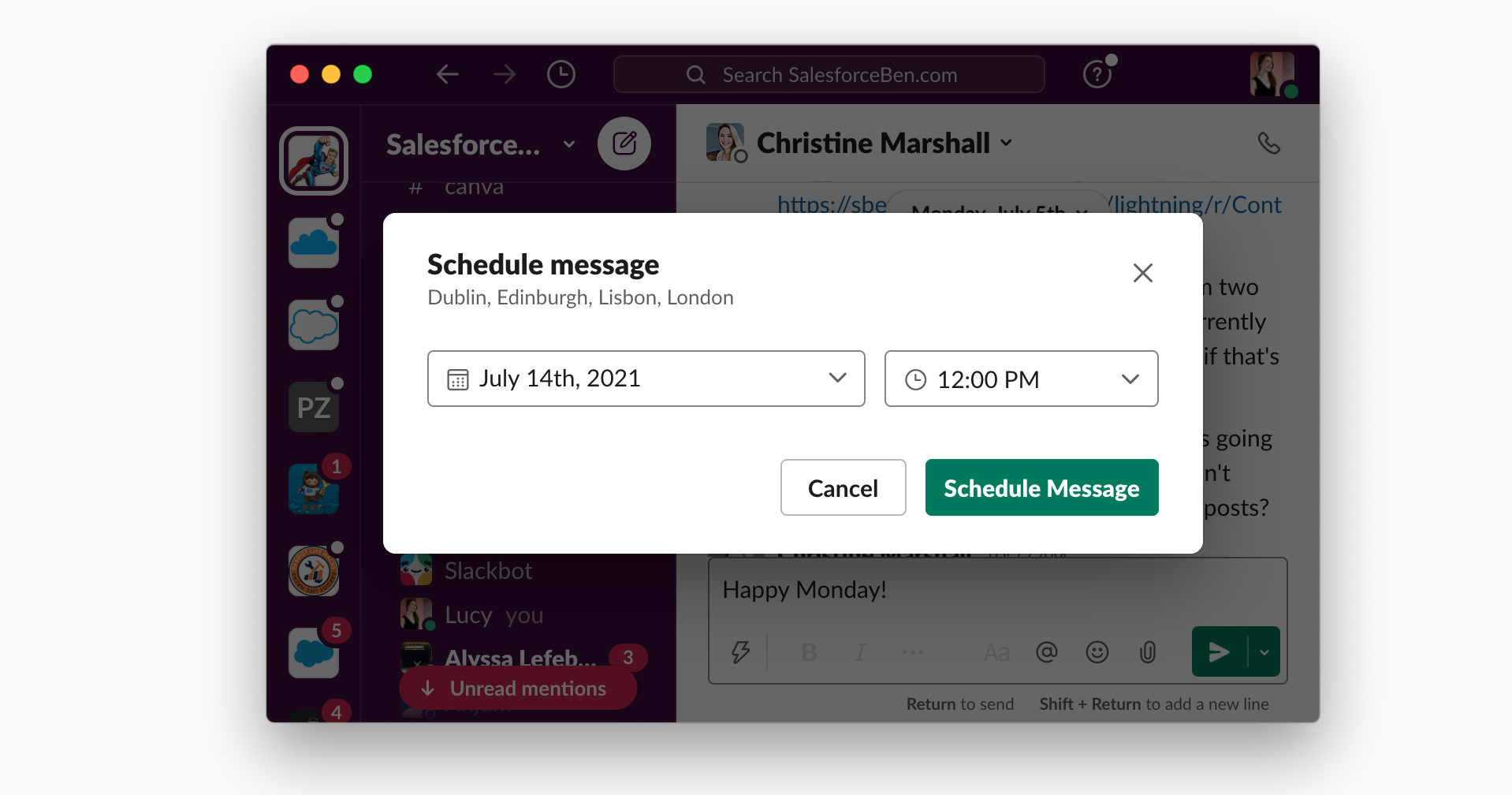Slack, the business communication platform powering organizations globally, has announced a spate of new features. ‘Schedule Send’ enables users to schedule a message to send at a specific time.
While seemingly simple, it’s one addition that’s got Slack fans talking. Many have shared how anticipated this feature is, and how they’ll put it to use. In this guide, I’ll cover some ways you can benefit from using Slack ‘Schedule message’.
How Slack Schedule Messages Works
Once rolled out to your workspace, a dropdown arrow will appear by the send button, which opens up suggested times to schedule the send, or set a custom time/date to be more specific. Simple, yet effective.
The message will appear sent from your own account, opening up many smart possibilities to use this feature.

You can schedule messages as a direct message between you and someone else, or to a channel. Note, to schedule send using the Slack mobile app (Android and iOS), press and hold the send button to reveal the scheduling options.
Once scheduled, you are able to view, edit and manage scheduled messages (reschedule, send now, or cancel).
“Teams shouldn’t be obligated to sync their schedules in order to communicate effectively.” – Slack
Use Cases for Scheduled Messages in Slack
We use Slack over here at SFB. We also have flexible working hours and a fast-paced team. This got me thinking: how could teams, like ours, take advantage of scheduling Slack messages? Here are four ways that could benefit your team.
Time Zones
The ability to schedule messages to deliver around people’s different time zones is a frequently referenced use case for this Slack feature.
Many roles have placed me in different time zones to my counterparts ie. the US, or India). Moreover, remote work has been normalized, with the COVID-19 pandemic resulting in team members dispersed even further (eg. internationally to be closer to family members).
Now, you can schedule messages to cut through the noise of other messages, and have them land right when your colleague gets online (wherever 9 am is for them!)
Daily Stand-ups
This seemed the most popular use voiced by Slack’s user community – some comments practical, some more comical. Say you have a team stand-up every day at 9 am. Maybe you’re not a morning person? Maybe you have to drop your kids off at school, or the cat at the vets? Regardless of which camp you fall into, use the schedule feature to make it appear like you’re online.
Paired with Slack’s video recordings, you can make your updates more impactful and take control of your schedule. Record an update, schedule it, and allow your team members to watch your update at their convenience. While this may sound utopian for most organizations, this way of working will enable teams founded on trust to excel.
The comical element? When people claim they could appear online, on autopilot, while elsewhere. Thank goodness for a better appreciation for work-life balance in most organizations…
Reminders for ’30 second tasks’
Most teams use a project management tool, such as Asana, JIRA, TaskRay, etc. that enables them to organize projects right down to the individual task – plus assign one-off tasks to team members, in a tag-team fashion.
What warrants being added to the project management tool? Something so small that it would take your colleague <30 seconds?
That’s the rule I use when communicating with Lottie, SalesforceBen.com’s Marketing Executive. Before I make a request, I ask: ‘will this take her more than 30 seconds to complete?’ If the answer is no, then I log it as an Asana task.
Should the answer be ‘yes, it will take <30 seconds’, then I will ping it on Slack. These are typically FYIs about content schedule changes, only relevant for a specific time of the day. I’ve started using Slack’s schedule feature to remind Lottie without bombarding her with emails, or without her having to set calendar invites to herself to be notified about last-minute content schedule changes. Scheduling via Slack removes overhead for both of us.

Brainwaves
Some people, myself included, will get random brainwaves throughout the evening/night/early morning. We may be itching to communicate it to our team, however, I pause to think: ‘is this a good time?’ our team are usually busy in the mornings, retreat for deep work until lunchtime, then converse in the early afternoon on either side of lunch, before an afternoon period of undisturbed work.
What if I could schedule my next big idea to land as everyone is engaged on Slack, and freed from the depths of concentration? Yes, it’s already working wonders…
Forgetten draft Slack messages, no more…
Hands up if you’re guilty of leaving a draft message unsent, accidentally? You genuinely may have been waiting for the optimal time to hit send for your colleague. Well, now you can schedule it instead!
Summary
I admit that I’m far from an expert Slack user – more a Slack fanatic – but I can already see how the ‘schedule send’ feature will benefit many teams operating in the reality of flexible work.
Slack is heading in the right direction – after all, marketers have had the ability to schedule an email campaign to be most impactful for a date/time for a decade or longer.
Most email marketing platforms have even progressed to infuse scheduling with AI to optimize/tailor the email delivery time to each individual prospect that’s part of a list (eg. Einstein Send Time Optimization for Marketing Cloud and Pardot).
The power of scheduling emails then extended to individual users, like within Gmail and its sophisticated counterpart, Boomerang.
Now Slack, too, can tap into the potential that scheduled messages promise – and the Slack user community agree – it’s about time!
Check out the other new additions to Slack – including Slack Huddles, recordings, and more.
More importantly – have I missed any good use cases for this feature? I would love to hear how you’re using scheduled messages, and how it’s improved your team’s operations, please comment below.

